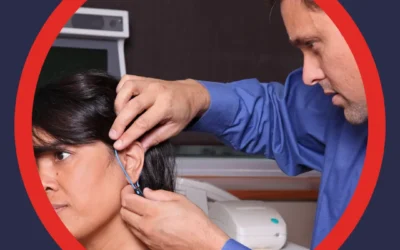Types of Hearing Aids: Which One is Right for You?
Types of hearing aids have evolved significantly over the years, becoming an indispensable tool for millions. Individualized choices are paramount, as no two hearing conditions are identical. Stay tuned as we explore what hearing aid types and costs are to help you navigate the myriad options.
A hearing aid is a compact electronic device worn in or behind your ear. It amplifies certain sounds, enabling individuals with hearing loss to engage more actively in daily activities. Comprising a microphone, amplifier, and speaker, the device captures sound waves, amplifies them, and directs the enhanced signals into your ear.
Hearing aids chiefly benefit those with sensorineural hearing loss, resulting from damage to the inner ear’s hair cells. This damage can stem from aging, diseases, noise exposure, or certain medications. The device magnifies incoming sound vibrations, which surviving hair cells convert into neural signals for the brain to interpret.
However, not all hearing aids work for everyone. The severity of your hearing loss, the condition of your inner ear, and even your lifestyle can affect which type of hearing aid is right for you. Finding the right fit for your needs is crucial for optimal hearing and overall well-being.
Understanding the Basics: What Types of Hearing Aids Are There?
Hearing aids come in various types and styles, each with unique features and functionalities. They operate on either analog or digital electronics, affecting how they amplify and process sound.
Analog vs. Digital
Analog hearing aids amplify all sounds equally and may have different settings for various environments. They are less common today. Digital hearing aids convert sound waves into digital signals, allowing for more nuanced sound processing. They are suitable for complex listening environments and are the most common type today.

Main Hearing Aid Types
We organize the different types of hearing aids and how they work into several categories:
Behind-The-Ear (BTE) Hearing Aids
Design: Sits behind the ear and connects to an ear mold or tubing.
Suitability: Fits a broad range of hearing loss and age groups.
Features: Easier to handle, but some find them bulky.
In-The-Ear (ITE) and In-The-Canal (ITC) Hearing Aids
Design: Fits inside the ear; ITE fills the ear bowl, and ITC sits deeper in the canal.
Suitability: Recommended for moderate to severe hearing loss.
Features: Discreet and easy to handle, but may have a shorter battery life.
Completely-In-The-Canal (CIC) and Invisible-In-The-Canal (IIC) Aids
Design: Almost entirely hidden within the ear canal.
Suitability: Ideal for mild to moderate hearing loss.
Features: Extremely discreet, but may be difficult to handle due to small size.
Receiver-In-Canal (RIC) and Receiver-In-The-Ear (RITE) Aids
Design: Similar to BTE but with a receiver in the ear or canal.
Suitability: Suitable for mild to profound hearing loss.
Features: Allows natural low-frequency sounds and amplified high-frequency sounds.
Special Types
CROS/BiCROS: Used when hearing loss is significant in one ear and minimal or none in the other.
Middle Ear, or Cochlear, Implants: Requires surgical implantation and is suitable for profound hearing loss.
Conclusion
Hearing aids offer a range of options. Your local hearing center can help you determine which options work best for you.
Hearing Aid Types and Costs: Investment vs. Benefits
The high cost of hearing aids puzzles many. Several factors contribute to this. Manufacturers invest millions in research and development, improving product quality but passing the cost to consumers. Also, low sales volume increases production costs. Audiologists provide essential services like programming and maintenance, which also adds to the overall price.
What’s Included in the Price?
The listed price often includes more than just the hearing aid device. It can cover fitting fees, adjustments, warranties, and aftercare. However, the price may only include the device if you buy online. Extra warranties or accessories will increase the final cost.
Bundling vs. Unbundling Costs
Audiologists may bundle services into a single price like a concierge service plan:
- Fittings
- Ongoing professional services
- Repairs
- The hearing aid device
Alternatively, you can opt to unbundle and pay for each service as needed.
Factors Affecting Hearing Aid Types and Costs
- Technology Level: Advanced features like Bluetooth and smartphone apps raise the cost.
- Hearing Aid Style: In-the-ear models generally cost more than behind-the-ear styles.
- Battery Type: Rechargeable batteries have higher upfront costs but offer long-term savings.
- Operational Features: Add-ons like noise reduction and tinnitus masking increase costs.
- Model Choice: Older, similar models can be more affordable.
- Support and Ongoing Care: Audiologists’ services increase the total price.
- Insurance Coverage: Some insurance plans partially cover the costs, reducing your financial burden.
Hearing aids are a significant investment, but considering their value and potential benefits, the cost often justifies itself. Factor in durability, possible insurance coverage, and required ongoing care to make an informed decision.
Explore more about hearing aid insurance benefits and how they work.
Considering Hearing Aid Types and Costs
Selecting the right hearing aid is crucial, and several factors should guide your choice. Here’s a detailed guide on what to consider.
Assessing Your Hearing Loss Severity
Hearing loss varies in degrees, from mild to profound. The severity impacts your choice significantly. An audiologist can provide an accurate diagnosis and guide you towards hearing aids best suited for your condition.
Lifestyle Needs and Technological Features
Beyond severity, your lifestyle demands unique considerations. Are you active and outdoorsy, or do you live more sedentary lives? Newer hearing aids offer Bluetooth connectivity, compatible with smartphones and other devices. These features can be beneficial for those always on the go.
Manual Dexterity
The design of the hearing aid and how well you can handle it also matters. Smaller devices can be hard to manage if you have limited manual dexterity. In such cases, behind-the-ear models might be a more practical choice.
Aesthetic Preferences
Looks aren’t everything, but they matter to some people. Hearing aids come in various styles and colors. Some fit entirely inside the ear, making them nearly invisible, while others are more noticeable.
Expert Guidance
An audiologist is your best resource for finding the perfect fit. We can offer advice tailored to your needs, especially with the influx of new technologies.
Questions to Ask Beyond What Types of Hearing Aids Are There?
The National Institute on Deafness and Other Communication Disorders recommends considering several questions:
- What features do I absolutely need?
- Does the device’s appearance matter to me?
- What’s the total cost, including potential add-ons?
- Do the benefits of new technologies justify higher costs?
- Is there a trial period, and what’s the duration?
- How long is the warranty, and what does it cover?
By giving attention to these aspects, you increase your chances of finding a hearing aid that serves you functionally and aesthetically best.
Read our buyer’s checklist for affordable hearing aids.

Embracing Better Hearing By Understanding the Different Types of Hearing Aids and How They Work
Selecting the perfect hearing aid involves carefully blending medical needs, lifestyle considerations, and budget factors. From understanding the severity of your hearing loss to balancing aesthetic preferences and technological features, choosing the right type of hearing aid is a personal journey that can significantly improve your quality of life.
If you grapple with these choices, professional guidance can make all the difference. At American Hearing and Audiology, we’re committed to helping you find the right hearing aid, offering ongoing support, and even assisting you in navigating through insurance options.
Take the first step towards enhanced hearing and overall well-being. Contact American Hearing and Audiology today for personalized assistance in choosing a hearing aid that aligns perfectly with your needs.



